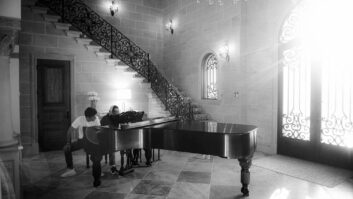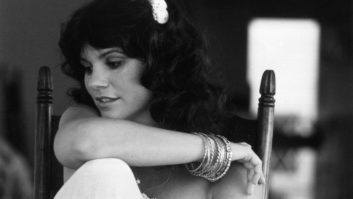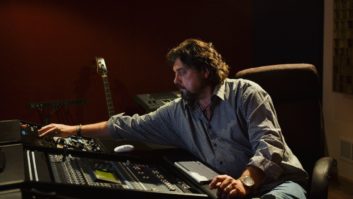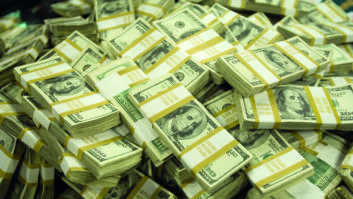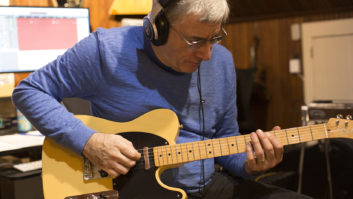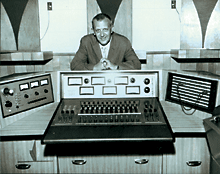
Just out of the Navy in 1946, guitarist Harold Bradley was anxious to record some country music. So he headed to Chicago to meet up with Pee Wee King.
Owen Bradley leans over his 3-track board at the Quonset hut
Photo: Courtesy Country Music Hall of Fame
“There really wasn’t a recording scene in Nashville,” says Bradley, now likely the most recorded guitarist in popular music history. “There was no Music Row and no A-Team of studio musicians.”
To that point, most of what we now know as classic country music had been recorded in other environs. The Carter Family and Jimmie Rodgers first recorded in the border town of Bristol, Va., and Rodgers’ first famed “Blue Yodel” was cut up in Camden, N.J. Atlanta; Charlotte, N.C.; Dayton, Ohio; and Cincinnati were viable places to record country music. But the presence of WSM AM 650 radio and the Grand Ole Opry meant that Nashville was attracting plenty of ace musicians and singers, and that “hillbilly” artists would do well to find places in Middle Tennessee to record rather than have to hit the road to make records.
In the mid-1940s, Eddy Arnold and Red Foley recorded at WSM’s studios, and by 1946, three WSM engineers took out a $1,000 loan and founded Castle Recording Laboratory in the Tulane Hotel, downtown at the corner of 8th Avenue N. and Church Street. Bradley recorded with Hank Williams at Castle, and the Tulane Hotel doors swung open to accommodate dozens of Opry stars. But the rise of television meant that WSM demanded more time of its engineers, and Castle’s reign as titan of Nashville’s studios was short-lived.
Flash to 1952, when Harold Bradley and brother Owen Bradley decided to open a film and television studio. By then, music publisher Acuff-Rose had established itself as a successful Nashville presence, and performing-rights organizations were collecting on songs played over the airwaves. The pieces were in place for a recording boom. The Bradleys started one studio, but the land owner tripled the rent and the brothers moved their operation to the Hillsboro Village neighborhood. In 1954, they bought a property on 16th Avenue, and that became the first studio on what is now known as Music Row. The Bradleys built a Quonset hut at the site, and in that hut they began recording music. Harold Bradley played guitar, banjo and bass, and Owen Bradley (a piano player) produced records.
The Quonset Hut operation’s success got the attention of RCA Records, and in 1957, RCA Studio B was built within walking distance of the Bradleys. The “A-Team” of musicians — a group that came to include Harold Bradley, guitarist Hank Garland, drummer Buddy Harman, pianist Floyd Cramer, pianist Hargus “Pig” Robbins, fiddler Tommy Jackson, steel guitarist Pete Drake (and later Lloyd Green), sax man Boots Randolph, bass player Bob Moore, guitarists Ray Edenton and Grady Martin, and vocal groups The Jordonaires and the Anita Kerr Singers — shuffled between the studios and played on thousands of records.
“We’d be at one studio or the other,” says Harold Bradley, who heads Nashville’s Musicians’ Union. “We were tremendously busy. No one can imagine it unless they lived through it. They scheduled the sessions around us. It was a great opportunity, and one that probably won’t happen again. There are great players in Nashville now, but there’s not one team of players.”
There was danger, though, in the form of a gyrating Memphis kid named Elvis Presley. His exciting new sound stole listeners from country and damaged the careers of Ernest Tubb, Carl Smith, Webb Pierce, Lefty Frizzell and others. Grand Ole Opry attendance slipped dramatically, and attempts by Little Jimmy Dickens, Pierce and others to shift into rockabilly were less than successful (though Dickens’ “I Got a Hole In My Pocket” is, in hindsight, a pretty slammin’ little record).
At first, the country labels reacted to Presley by recording older singers doing material geared toward teens — Pierce’s nasally “Teenage Boogie” is the most unintentionally hilarious example — but then Capitol Records producer Ken Nelson took two younger artists and have them record in a pop leaning rather than rockabilly style. Ferlin Husky’s “Gone” and Sonny James’ “Young Love” became monster hits, crossing into the upper reaches of the pop charts. The A-Team; producers Nelson, Bradley Don Law and Chet Atkins; and engineers such as Bill Porter were skilled enough to shift styles, and what is now called “The Nashville Sound” was born. The A-Team also provided brilliant assistance on Nashville-recorded rock hits such as Presley’s “Are You Lonesome Tonight,” Brenda Lee’s “Rockin’ Around the Christmas Tree,” Roy Orbison’s “Only the Lonely” and the Everly Brothers’ “Bye, Bye Love.”
Away from Music Row, a thriving R&B scene was taking shape. Etta James and Ruth Brown recorded marvelous works in Nashville, and Excello Records released numerous important sides (Arthur Gunter’s “Baby Let’s Play House” among them). And the Row studios sometimes opened to R&B; Gene Allison’s “You Can Make It If You Try” was recorded at the Bradleys’ studio.
Many listeners didn’t realize that the R&B and rock hits were cut in Nashville studios as the city became better known for delivering country narratives done up with big vocal choruses and pop arrangements. One of those “Nashville Sound” hits, Don Gibson’s “Oh Lonesome Me,” was the first major Nashville recording in which the drums were miked. And by 1960, Presley’ rock ‘n’ roll scare wasn’t so scary, and Nashville was the second-largest recording center in the United States, after Los Angeles.
In 1962, the Bradleys sold their Quonset Hut to Columbia Records, agreeing to go without a studio of their own for two years. As the hut became home to Johnny Cash, Flatt & Scruggs and other Columbia acts, Owen Bradley scouted, planned and opened Bradley’s Barn in Mt. Juliet, Tenn. Owen Bradley was an architect of Music Row and a visionary who moved off the Row when it became prudent.
“That opened in 1965,” says Harold Bradley. “I remember that it was a 52-mile round-trip from Nashville, and there was one Dairy Dip where you could eat along the way. But after Bradley’s Barn, things started opening up in different places, aside from Music Row. You had Woodland Studios in East Nashville, and then you had other studios opening up near the Row. Quad was one, and Sound Emporium. All of a sudden, there was a blossoming.”
In the 1960s, and since then, Nashville was the undisputed center of the country music recording industry. To be sure, Buck Owens, Merle Haggard and others made great records out West. But the majority of the hits were cut in Nashville, and the majority of the recording musicians, engineers, songwriters and publishers who mattered were in the 615 area code. Texas and California produced some invigorating country music, but Nashville musicians and producers did not settle for a tepid mainstream. Bob Dylan came to town to record with Music City pros for albums Blonde on Blonde, John Wesley Harding and Nashville Skyline, and The Byrds charged into Nashville to record the Sweetheart of the Rodeo album (with significant contributions from steel-guitar innovator Lloyd Green). Country sounds entered mainstream pop and rock. And ABC-TV’s The Johnny Cash Show was a weekly late-1960s and early 1970s showcase for collisions of country, rock, pop and jazz.
After one Johnny Cash Show taping, Neil Young called pals James Taylor and Linda Ronstadt into Quadraphonic Recording Studios, just off Music Row. They laid down tracks that would be featured on Young’s Heart of Gold. And in 1972, the Nitty Gritty Dirt Band invited a bevy of old-time country performers — including Mother Maybelle Carter, Roy Acuff and Jimmy Martin — to Woodland Studios to make the Will the Circle Be Unbroken album, a confluence of long-haired country-rockers and old-school, first- and second-generation country stalwarts.
Perhaps the most memorable force of Nashville’s 1970s was the “Outlaw Movement,” in which Bobby Bare, Waylon Jennings, Willie Nelson and other artists temporarily wrested creative control from Music Row labels and producers. This movement resulted in the country’s first Platinum album sales and some astounding music, but by the 1980s, it was clear that any victories had been pyrrhic in nature. Today, three decades after artists won creative control, most major recording projects are helmed by a big-name producer, and many of those producers also work as label bosses. Artists’ instincts are, in fact, minority opinions.
In the early 1980s, the Outlaw scene died down and gave way to smoother sounds, as the Urban Cowboy craze caught on. But the mid- and late 1980s brought what Steve Earle termed the era’s “Great Credibility Scare,” in which Earle, Dwight Yoakam, Nanci Griffith, Lyle Lovett, The O’Kanes, Foster & Lloyd and others stretched country’s parameters without straying from the music’s roots. And neo-traditionalists George Srait, Ricky Skaggs and Randy Travis revived interest in the traditions of Hank Williams, Bill Monroe and Lefty Frizzell.
These days, record company consolidations and sales slumps are making things difficult along the Music Row forged by pioneers like the Bradleys and Atkins. Nashville music isn’t defined by any present-day unease, though. Nashville is the fuzztone electric guitar played by Grady Martin on Marty Robbins’ “Don’t Worry.” It is the soulful balm of Gene Allison’s “You Can Make It If You Try,” and the pristine engineering and trembling vocal presence on Roy Orbison’s “Only the Lonely.” It is a tumbling Atkins guitar lead, the thump of Bob Moore’s bass, the plaintive voice of Loretta Lynn and the growl of Kris Kristofferson. It is Brent Mason’s chicken-pickin’ Telecaster and Jerry Douglas’ dobro. It is Gene Vincent at the Bradleys’ studio, singing, “Be bop a lula, she’s my baby doll, my baby doll, my baby doll.” It is now, and ever shall be.
